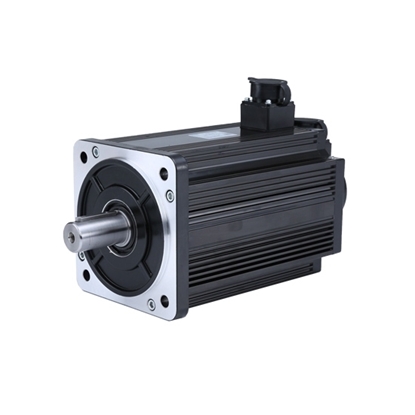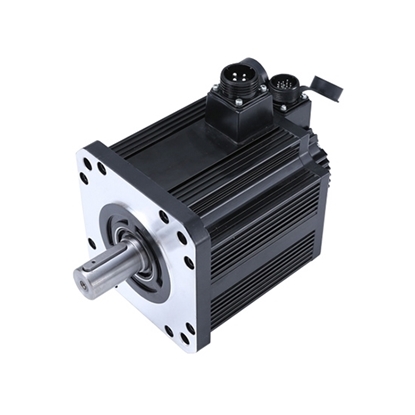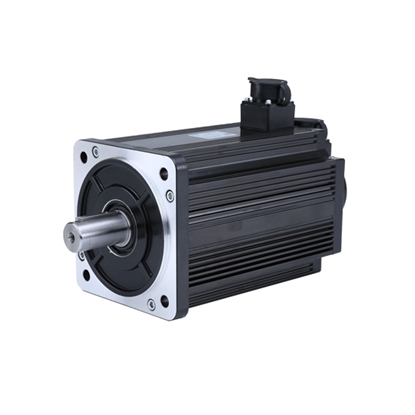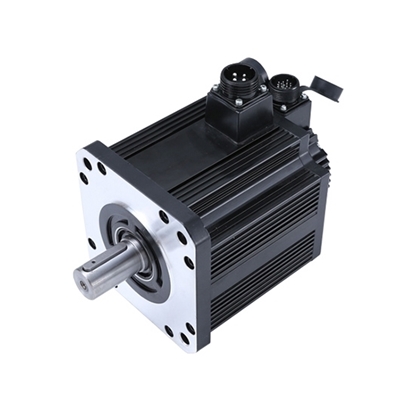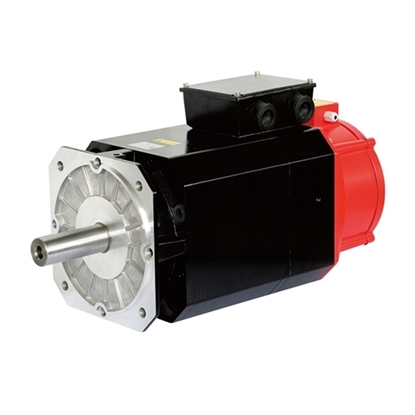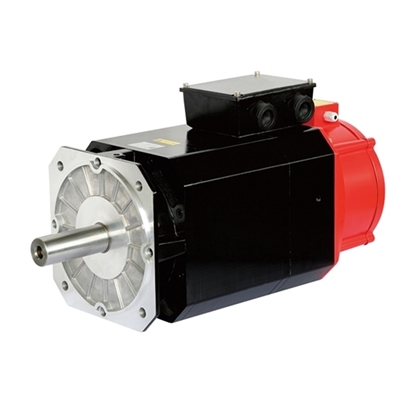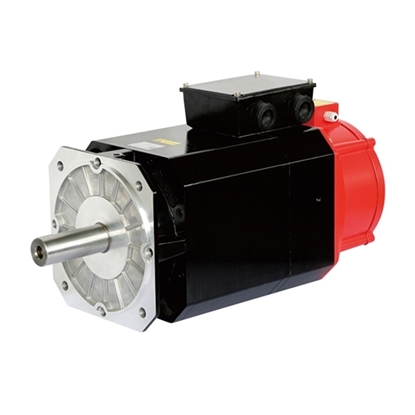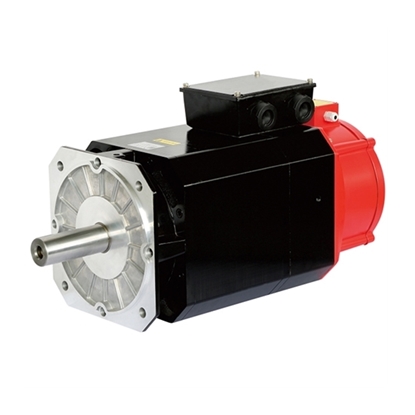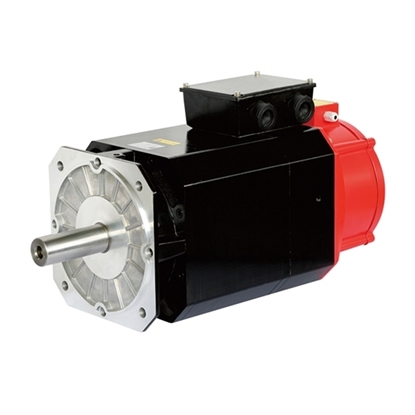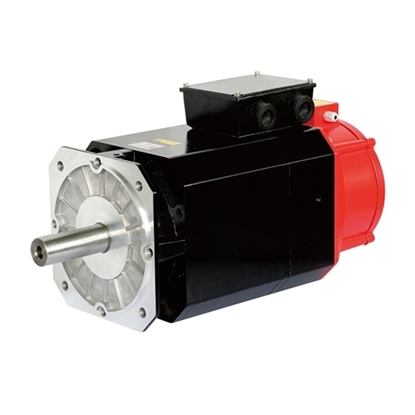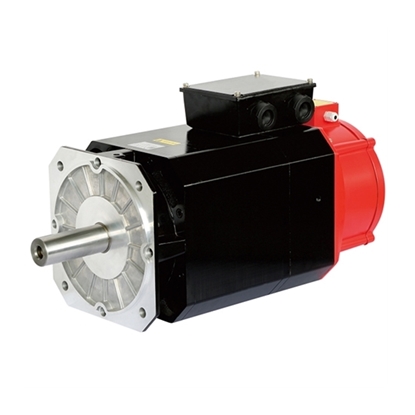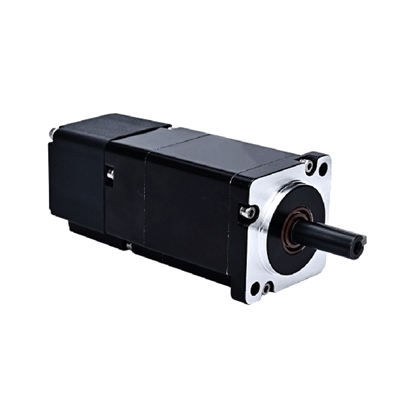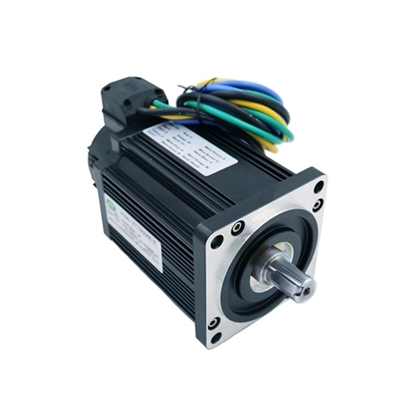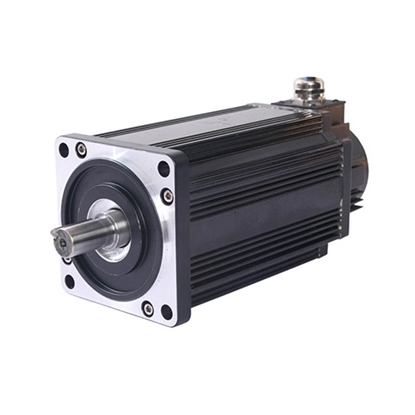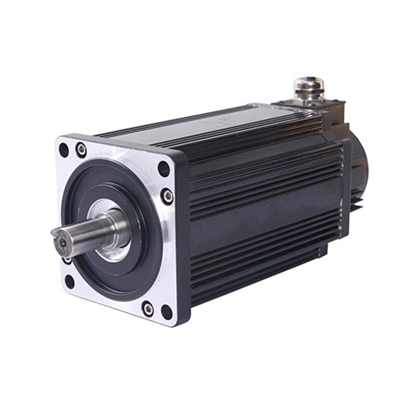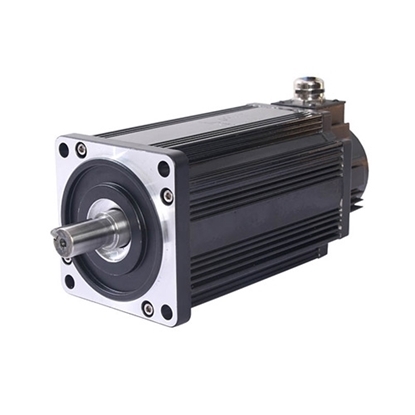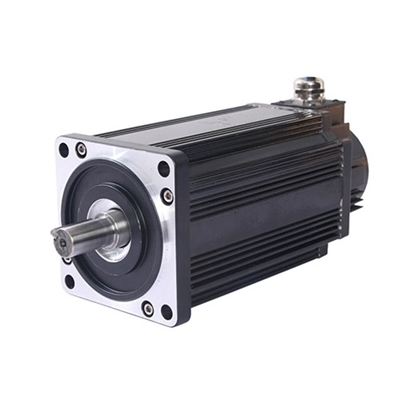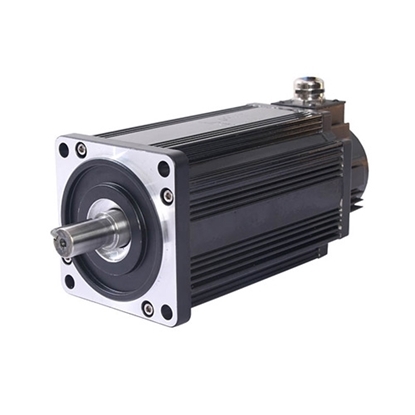Servo Motors
5 hp (3.8 kW) AC Servo Motor, 15 Nm, 2500 rpm
6 hp (4.5 kW) AC Servo Motor, 20 Nm, 2000 rpm
5.5 kW AC Servo Motor, 27 Nm, 2000 rpm
10 hp (7.5 kW) AC Servo Motor, 48 Nm, 1500 rpm
3 hp (2.2 kW) AC Servo Spindle Motor, 14 Nm, 1460 rpm
5 hp (3.7 kW) AC Servo Spindle Motor, 24 Nm, 1460 rpm
5.5 kW AC Servo Spindle Motor, 35 Nm, 1460 rpm
10 hp (7.5 kW) AC Servo Spindle Motor, 50 Nm, 1460 rpm
9.5 kW AC Servo Spindle Motor, 60 Nm, 1500 rpm
11 kW AC Servo Spindle Motor, 70 Nm, 1500 rpm
20 hp (15 kW) AC Servo Spindle Motor, 95 Nm, 1500 rpm
100W 24V DC Servo Motor, 0.32 Nm, 3000 rpm
200W 24V DC Servo Motor, 1.27 Nm, 1500 rpm
400W 24V DC Servo Motor, 2.25 Nm, 1500 rpm
500W 48V DC Servo Motor, 3 Nm, 1500 rpm
800W 48V DC Servo Motor, 5 Nm, 1500 rpm
1000W 48V DC Servo Motor, 6.3 Nm, 1500 rpm
1200W 48V DC Servo Motor, 4.5 Nm, 2500 rpm
1500W 48V DC Servo Motor, 9.5 Nm, 1500 rpm
2000W 48V DC Servo Motor, 7.5 Nm, 2500 rpm
Servo motor is a rotating actuator that controls the operation of mechanical components in the servo system, making the control speed and position very accurate. It can be divided into two main categories: AC and DC servo motors.
The speed of the servo motor rotor is controlled by the input signal and can react quickly. In automatic control systems, servo motors can be used as actuators. Servo motor has the characteristics of small electromechanical time constant and high linearity, and it can convert the received electrical signal into angular displacement or angular velocity output on the motor shaft.
ATO gives you unprecedented choice and flexibility from a wide range of standard servo motors and servo drives, you can select the best one for your applications. We offer different types of servo motors: Brushless AC servo motors, brushless DC servo motors, RC servo motors, linear servo motors, and gear servo motors. They feature compact structure, best price, good performance, fast response, smooth rotation and high torque.
Servo Motor Advantages
- High output: Power in relation to the servo motor size and weight.
- Encoder: Determines the accuracy and resolution of the servo motor.
- High-efficiency: The servo motor can approach 90% efficiency at light loads.
- High Torque to Inertia Ratio: The servo motor can rapidly accelerate loads.
- A servo motor has 2-3 times continuous power for short periods.
- No autorotation when the signal voltage is zero, and the speed decreases at a uniform speed with the increase of torque.
Basic Explanations on Types of Servo Motors
AC Servo Motors
 AC servo motors are also brushless motors, which are divided into synchronous and asynchronous motors. At present, synchronous motors are generally used in motion control. They have a large power range and can achieve great power. Large inertia, low maximum rotation speed, and rapid decrease as the power increases. Therefore, it is suitable for low-speed and smooth-running machines. The structure of AC servo motor can be divided into two parts, namely stator part and rotor part. The stator structure is basically the same as that of the rotary transformer, and the two phase windings with 90 degrees of electric angle are placed in the stator core. One group is the exciting winding and the other group is the control winding. ATO AC brushless servo motors provides higher torque, come with 40mm to 180mm different square flange size, power rating from 50W to 7.5kW and speed range from 1000 rpm to 3000 rpm. Spindle AC servo motor with power rating from 50W to 15kW (20 hp) and wide range holding torque from to 0.16 Nm to 96 Nm.
AC servo motors are also brushless motors, which are divided into synchronous and asynchronous motors. At present, synchronous motors are generally used in motion control. They have a large power range and can achieve great power. Large inertia, low maximum rotation speed, and rapid decrease as the power increases. Therefore, it is suitable for low-speed and smooth-running machines. The structure of AC servo motor can be divided into two parts, namely stator part and rotor part. The stator structure is basically the same as that of the rotary transformer, and the two phase windings with 90 degrees of electric angle are placed in the stator core. One group is the exciting winding and the other group is the control winding. ATO AC brushless servo motors provides higher torque, come with 40mm to 180mm different square flange size, power rating from 50W to 7.5kW and speed range from 1000 rpm to 3000 rpm. Spindle AC servo motor with power rating from 50W to 15kW (20 hp) and wide range holding torque from to 0.16 Nm to 96 Nm.
DC Servo Motors
 DC servo motors generally have a separate DC source in the field of winding and armature winding. Control can be archived by controlling the armature current or the field current. Depending on the application, the control shall be applied to the DC servo motor. Due to low armature inductance, dc servo motors provide very accurate and fast response to start or stop command signals. DC servo motors are used in similar equipment and computer numerical control machines. Actuators in various digital control systems. Power drives that require precise control of constant speed or require precise control of speed change curves. ATO DC brushless servo motors are designed to used at 24V/48V DC voltage, feedback with 2500 PPR increment encoder, with brake option available and achieve higher accuracy and resolution.
DC servo motors generally have a separate DC source in the field of winding and armature winding. Control can be archived by controlling the armature current or the field current. Depending on the application, the control shall be applied to the DC servo motor. Due to low armature inductance, dc servo motors provide very accurate and fast response to start or stop command signals. DC servo motors are used in similar equipment and computer numerical control machines. Actuators in various digital control systems. Power drives that require precise control of constant speed or require precise control of speed change curves. ATO DC brushless servo motors are designed to used at 24V/48V DC voltage, feedback with 2500 PPR increment encoder, with brake option available and achieve higher accuracy and resolution.
RC Servo Motors
 RC servo motor, short for radio control servo motor, can also be regarded as a DC servo motor, but its characteristics and application fields are different from DC servo motors. RC servo motors can accurately control speed and position accuracy, and can also convert voltage signals into torque and speed to drive control objects. Servo motor rotor speed is controlled by the input signal, and can respond quickly. In the automatic control system, RC servo motor used as an executive element, and has the characteristics of small electromechanical time constant, high linearity, starting voltage, can convert the electrical signals received into the angular displacement or angular velocity output on the motor shaft. When the signal voltage is zero, there is no rotation phenomenon, and the speed decreases uniformly with the increase of torque. ATO provide large selection of micro RC servo motor for remote control and different steering equipment, 6V, 7.4V or 12V operating voltage, stall torque from 20, 30, 40, 60 kg·cm to high torque 85 kg·cm to meet your needs.
RC servo motor, short for radio control servo motor, can also be regarded as a DC servo motor, but its characteristics and application fields are different from DC servo motors. RC servo motors can accurately control speed and position accuracy, and can also convert voltage signals into torque and speed to drive control objects. Servo motor rotor speed is controlled by the input signal, and can respond quickly. In the automatic control system, RC servo motor used as an executive element, and has the characteristics of small electromechanical time constant, high linearity, starting voltage, can convert the electrical signals received into the angular displacement or angular velocity output on the motor shaft. When the signal voltage is zero, there is no rotation phenomenon, and the speed decreases uniformly with the increase of torque. ATO provide large selection of micro RC servo motor for remote control and different steering equipment, 6V, 7.4V or 12V operating voltage, stall torque from 20, 30, 40, 60 kg·cm to high torque 85 kg·cm to meet your needs.
Linear Servo Motors
 Linear servo motor is a kind of motor similar to position rotation servo motor. But it has additional mechanisms to change the output back and forth from the direction of the circle. The working principle likes torque motors, but they are turned on and pushed flat. Electrical energy is converted into linear mechanical energy with high efficiency through electromagnetic interaction between coil assembly (main part) and permanent magnet assembly (minor part). Other common names for major components are motor, moving part, slide or slide, while minor components are also called magnetic circuits or tracks. ATO linear servo motors with rated power from 400W to 5.5kW, wide range rated torque from 1.27 Nm to 35 Nm, maximun thrust from 1.27 kN to 56 kN, maximum stroke 800mm, 1500mm, 1800mm for selection.
Linear servo motor is a kind of motor similar to position rotation servo motor. But it has additional mechanisms to change the output back and forth from the direction of the circle. The working principle likes torque motors, but they are turned on and pushed flat. Electrical energy is converted into linear mechanical energy with high efficiency through electromagnetic interaction between coil assembly (main part) and permanent magnet assembly (minor part). Other common names for major components are motor, moving part, slide or slide, while minor components are also called magnetic circuits or tracks. ATO linear servo motors with rated power from 400W to 5.5kW, wide range rated torque from 1.27 Nm to 35 Nm, maximun thrust from 1.27 kN to 56 kN, maximum stroke 800mm, 1500mm, 1800mm for selection.
Gear Servo Motors
 Gear servo motor is a kind of motor which can produce high torque when the low speed motor output. This type of motors are used in many different applications and are commonly found in homes and workplaces. A gear servo motor can run on either AC or DC motors. The output range of a gear motor can be between 1200 and 3600 revolutions per minute or RPM. The purpose of the gearbox is to reduce the speed and thus produce a different torque at the end of the shaft. Torsional stiffness is the torsional resistance generated when torque is applied to motor shaft, transmission element and load. An infinitely rigid system can transfer torque to the load without angular deflection around the axis of rotation. However, even the strongest steel shafts can warp slightly under heavy load. The deflection varies with the applied torque, the material of the transmission element and its shape. It makes intuitive sense that long, thin parts are more flexible than short, thick ones.
Gear servo motor is a kind of motor which can produce high torque when the low speed motor output. This type of motors are used in many different applications and are commonly found in homes and workplaces. A gear servo motor can run on either AC or DC motors. The output range of a gear motor can be between 1200 and 3600 revolutions per minute or RPM. The purpose of the gearbox is to reduce the speed and thus produce a different torque at the end of the shaft. Torsional stiffness is the torsional resistance generated when torque is applied to motor shaft, transmission element and load. An infinitely rigid system can transfer torque to the load without angular deflection around the axis of rotation. However, even the strongest steel shafts can warp slightly under heavy load. The deflection varies with the applied torque, the material of the transmission element and its shape. It makes intuitive sense that long, thin parts are more flexible than short, thick ones.
How to Choose a Right Servo Motor?
Each type of servo motor has parameters such as rated torque, maximum torque, and servo motor inertia in its specifications. There must be a correlation between each parameter and the load torque and load inertia. The output torque of the servo motor must meet the requirements of the motion conditions of the load mechanism such as the acceleration and weight of the mechanism. The motion conditions of the mechanism (horizontal and vertical rotation) are not directly related to the output of the servo motor, but in general, the higher the output of the servo motor, the higher the relative output torque.
The choice of servo motor is not only influenced by the weight of the mechanism, but also the equipment motion conditions will change the choice of servo motor. The greater the inertia, the greater the acceleration and deceleration torque, and the shorter the acceleration and deceleration time, the greater the servo motor output torque. When selecting servo motor specifications, follow the steps below.

- When the maximum output power torque of the initial selection of the servo motor must be greater than the acceleration torque + load torque, other models must be selected for verification until the symbol meets the requirements.
- The load torque is calculated based on the load weight, structure, coefficient of friction and operating efficiency.
- The load inertia of the mechanism is calculated by selecting the appropriate load inertia correction formula according to the requirements of the operating conditions.
- According to the load inertia amount and servo motor inertia, choose the appropriate false selected servo motor specification.
- Calculates the continuous instantaneous torque based on the load torque, acceleration torque, deceleration torque and holding torque.
- Clarify the motion conditions of the load mechanism, i.e. acceleration and deceleration speed, motion speed, mechanism weight, mechanism motion, etc.
- The acceleration torque and deceleration torque are calculated by combining the inertia of the servo motor and the load inertia.
How to Control a Servo Motor?
Servo motors generally have three control modes, namely: Speed control mode, torque control mode and position control mode. Both speed control and torque control are controlled by analog, while position control is controlled by sending pulses.
Servo Motor Position Control
The position control method generally determines the rotation speed by the frequency of externally input pulses, and determines the rotation angle by the number of pulses. There are also some servo drives that can directly assign speed and displacement through communication. Because the position mode can have very strict control on speed and position, it is generally used in positioning devices, such as CNC machine tools, printing machinery and so on.
Servo Motor Speed Control
The rotation speed can be controlled by analog input or pulse frequency. When there is outer loop PID control of the upper computer control device, the speed mode can also be used for positioning. However, the position signal of the motor or the position signal of the direct load must be fed back to the upper computer for calculation. Speed mode also supports direct load outer loop detection position signal. At this time, the encoder at the motor shaft end only detects the motor speed, and the position signal is provided by the direct detection device at the final load end. This has the advantage of reducing errors in the intermediate transmission process and increasing the positioning accuracy of the entire system.
Servo Motor Torque Control
The specific method is to set the external output torque of the servo motor shaft through the input of the external analog quantity or the assignment of the direct address. The specific performance is: For example, if 10V corresponds to 5Nm, when the external analog quantity is set to 5V, the motor shaft output is 2.5Nm. If the motor shaft load is lower than 2.5Nm, the servo motor rotates in a clockwise direction; when the external load is equal to 2.5Nm, the servo motor does not rotate; when the external load is greater than 2.5Nm, the motor rotates in an anticlockwise direction. The setting torque can be changed by instantly changing the analog setting. It can also be achieved by changing the value of the corresponding address through communication. Its application is mainly in winding and unwinding devices that have strict requirements on the force of the material, such as winding devices or fiber optic equipment.

